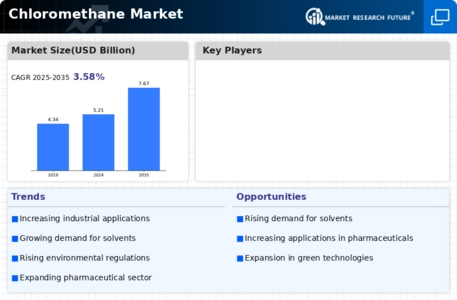Top Industry Leaders in the Chloromethane Market

Chloromethane, once a household name synonymous with refrigerators, has carved a surprisingly diverse niche in the global chemical landscape. While its historical use as a refrigerant has largely been phased out due to environmental concerns, chloromethane now fuels myriad industries, from pharmaceutical production to silicone elastomers for construction and automotive applications.
Market Overview and Share Drivers:
Chloromethane, also known as methyl chloride, exists naturally in seawater and the atmosphere, but for commercial purposes, it's primarily produced synthetically from methanol and hydrochloric acid. This versatile chemical boasts several properties that make it attractive across various sectors:
-
Chemical Intermediate: Chloromethane acts as a key building block for producing important chemicals like methyl silicones, pharmaceuticals, agrochemicals, and refrigerants (albeit non-CFC ones). -
Effective Solvent: Its ability to dissolve a wide range of substances makes it invaluable in paint stripping, polymer production, and textile processing. -
Methylating Agent: It readily transfers methyl groups to other molecules, playing a crucial role in organic synthesis for various chemicals and pharmaceuticals.
The factors influencing market share in this dynamic sphere include:
-
Regional Demand: Asia-Pacific currently dominates, driven by rapid industrialization and growing demand in sectors like construction, electronics, and automobiles. China takes the lead, followed by India and other Southeast Asian nations. -
Feedstock Availability: Access to affordable methanol and hydrochloric acid is crucial for cost-competitive production. North America boasts a strong advantage in this regard, with abundant shale gas reserves as a readily available source of raw materials. -
Technological Advancements: Developing greener production processes, exploring substitute feedstocks like biomass, and innovating in downstream applications offer a competitive edge. -
Stringent Regulations: Environmental concerns and restrictions on chloromethane's use in certain applications necessitate compliance with evolving regulations, impacting market dynamics. -
Vertical Integration: Gaining control over the entire supply chain, from feedstock acquisition to finished product distribution, can bolster operational efficiency and cost competitiveness.
Competitive Strategies: Keeping It Cool Under Pressure
To grab a larger share of the chloromethane market, companies are deploying a range of strategies:
-
M&A Activity: Consolidation through strategic acquisitions and mergers is evident, with giants like Dow Chemical and ExxonMobil expanding their global footprint and product portfolios. -
Regional Focus: Tailoring production and marketing strategies to cater to specific regional needs and regulations is crucial for success. -
Diversification: Offering a diverse range of chloromethane derivatives and catering to multiple downstream applications minimizes dependence on any single segment. -
Sustainability Initiatives: Investing in eco-friendly production processes, promoting carbon capture and utilization technologies, and developing bio-based chloromethane production methods gain favor with environmentally conscious consumers and regulators. -
Partnerships and Collaborations: Joining forces with research institutions, technology providers, and downstream users fosters innovation and facilitates market access.
Key Players :
- Dow Chemical Company (U.S)
- Asahi Glass Co. Ltd (Japan)
- Gujarat Alkalies and Chemicals Ltd (India)
- Alfa Aesar (U.S)
- Akzonobel N.V. (Europe)
- Solvay SA (Europe)
- INEOS Group (Europe)
- Tokuyana Corporation (Japan)
- Shin Etsu Chemical Co.Ltd (Japan)
- Occidental Chemical Corporation (U.S)
Recent Developments :
-
October 2023: Several chemical manufacturers collaborate to develop a next-generation silicone elastomer based on chloromethane, promising improved fire resistance and environmental benefits. -
November 2023: A research team reports on the potential use of chloromethane as a fuel component for rockets and satellites, opening up new avenues for the future of space exploration. -
December 2023: Dow Chemical unveils a new chloromethane recycling technology that significantly reduces waste and energy consumption, gaining traction with sustainability-focused customers. -
July 2020, Solvay SA launched a new project to expand chloromethane production throughout Europe. The project aimed to boost Solvay's capacity to fulfill Europe's growing demand for chloromethane while also improving the European chloromethane market's overall competitiveness.
November 2019, The Composites business of Ashland Holdings Inc. has been acquired by Ineos Group Limited. The acquisition featured chloromethane production, which was expected to boost Ineos' position in the worldwide chloromethane market and provide its clients with a broader choice of products.
May 2019, Gujarat Alkalies and Chemicals Limited, based in Gujarat, India, announced the expansion of its chloromethane factory. The expansion was designed to boost the company's production capacity and competitiveness in the worldwide chloromethane market.

